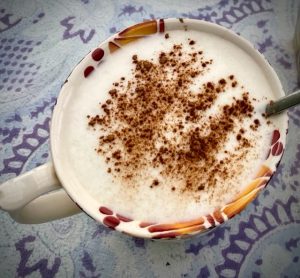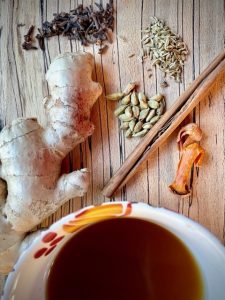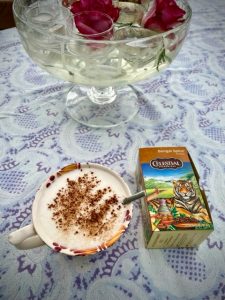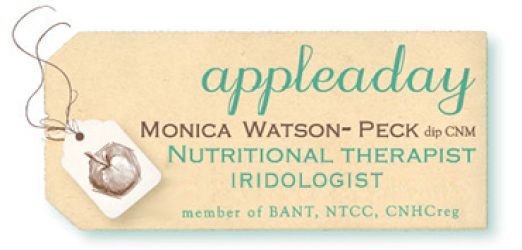We may think of today’s chai and chai latte as being a novel drink but it actually began life over 5000 years ago in India, when a king supposedly ordered his Ayurvedic doctor to make a healing spiced beverage.

Back then in India, chai was a concoction of warming spices and milk with no tea at all. It was definitely a far cry from the processed powdered or syrupy mixes we find today in many cafes and supermarkets. Most of these sweetened chai ‘teas’ have nothing to do with the original beverage with its warming spices and antioxidant and anti-inflammatory properties.
Some teae facts:
The word chai is Hindi for tea. Hence chai tea actually translates to tea tea, which must generate a few chortles by anyone who speaks Hindi. The Indian Masala chai (= spiced tea) is a closer fit to our current western chai drink.
Just to confuse things more, the Indian word chai comes from the Chinese for tea, cha, which makes sense as that’s where the story of tea began, back in 2737 BC, apparently. Whether this date is accurate or not, containers of tea were found in tombs dating back to the Han dynasty around 206BC. By 618 AD it had become the national drink of China. Extraordinary that it wasn’t until the 16th century that tea made its way to Europe, when Dutch merchants sent a consignment back to Holland. The cost, however, was prohibitive so it remained a drink only for the wealthy classes.
It was in the mid 1800s that the British decided to curb the stronghold China had on tea production by planting regions of India with these camellia sinensis bushes (sinensis = Latin ‘from China’). These thrived in the climate – and continue to thrive. China, however, is still the biggest tea producer in the world with India following second place.
Back to chai:
It seems that at this point, in the mid 1800s, black tea made its way into the Indian masala chai milky spiced drink. It didn’t catch on locally as black tea was still too expensive. According to an online article in The Spruce Eats it wasn’t until the 1960s that masala chai with black tea became more popular in India, mainly due to tea production becoming mechanised and more affordable.
The two black teas most often found in traditional chai are Assam and Darjeeling, both native to India. However, these days we use everything from green tea to yerba mate and red rooibos – or no tea at all, just the spices with milk.
What spices are in your chai?
It’s easy to make your own spiced chai or chai latte. Here are various spices you could use, some more common to chai than others. if you’re only using spices they should steep in boiling water for about 15 minutes. If adding tea, then 5 minutes is the time recommended. When I made my chai latte I steeped the spices first and then added the tea after 15 minutes, for another 5 minutes. And then the frothed oat milk. It was delicious and well worth the process!
The health benefits of chai will depend on the spices used, although you’ll see that most of them support digestion.

Most traditional chai includes cardamom, a spice which helps with a wide range of gastro intestinal complaints, from nausea to bloating,. Chewing on the seed can certainly improve bad breath. It’s a calming anti inflammatory spice with similar anti bacterial properties to clove.
Ginger is another common chai component with its gingerol oil giving that distinctive spicy flavour. It’s such a powerful antioxidant and anti inflammatory its health benefits range from digestive and nausea support to anti bacterial effects, blood balancing support and much more.
Cinnamon is another common spice, with a plethora of health benefits due to its antioxidants which in turn have anti inflammatory effects. I’ve read claims that it can reduce CRP, a marker for inflammation, but haven’t found more than just the claim. Its blood sugar benefits are well documented, not just by improving insulin sensitivity, but also slowing down the amount of sugar entering the blood after a meal. Cinnamon’s oil, cinnamaldehyde, accounts for a lot of its antimicrobial and anti-parasitic properties.
Clove is another common spice in chai (you only need a teensy amount as it can completely take over). This is another digestive supportive spice, and also an antioxidant and an anti inflammatory. Its eugenol oil acts as an antiseptic, hence the reason for its traditional use in dentistry and in toothpaste and mouthwash.
Other spices you might like to add to your chai are black pepper or fennel (the latter are in my above photo). Again, its volatile oils such as rosmarinic acid and chlorogenic acid, as well as quercetin and apigenin, add to its antioxidant benefits and antimicrobial, antiviral properties.
Star anise or aniseed is another possible addition to give chai that distinctive sweet, but more licorice, taste. Aniseed is known for digestive support and is an anti-spasmodic a.o. Digestive support supplements and teas often contain anise eg. Floradix has an anise-caraway-fennel herbal tea which can help with flatulence, constipation and bloating. Aniseed has similar blood sugar balancing properties to cinnamon by regulating certain digestive enzymes involved in carb metabolism. The main compound of star anise oil, anethole, is said to be effective as an antimicrobial, so one can assume it’s another effective herb for oral health, killing bacteria and improving bad breath.

Recently I discovered Celestial seasonings make a wonderful Bengal spice tea, which has become a daily treat of late. Three quarters of a cup of boiling water steeped for 15 minutes then topped with frothed oat milk, delicious! It satiates and satisfies any itch I may have for a sweet treat.
When I read the list of ingredients on the Celestial Seasonings box I can well imagine it is very similar to the original healing spice mix that king in India asked his ayurvedic doctors to put together some 5000 years ago.
Let me know how you get on with your chai recipes!
Credits: Thank you to Healthline, Future Generation Co, Holy Cow Chai history, The Spruce Eats, Amala Chai, The Tea Kitchen for some fascinating reads and chai tea facts.
